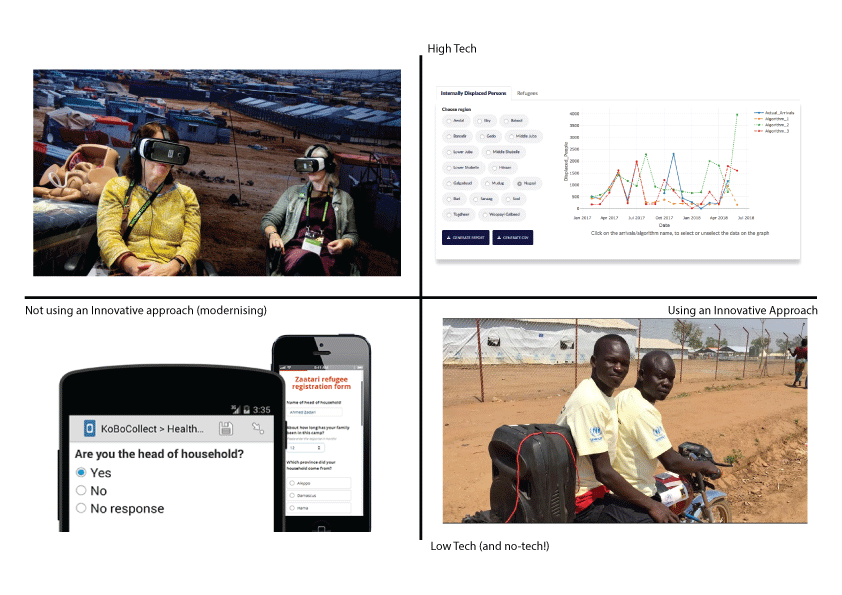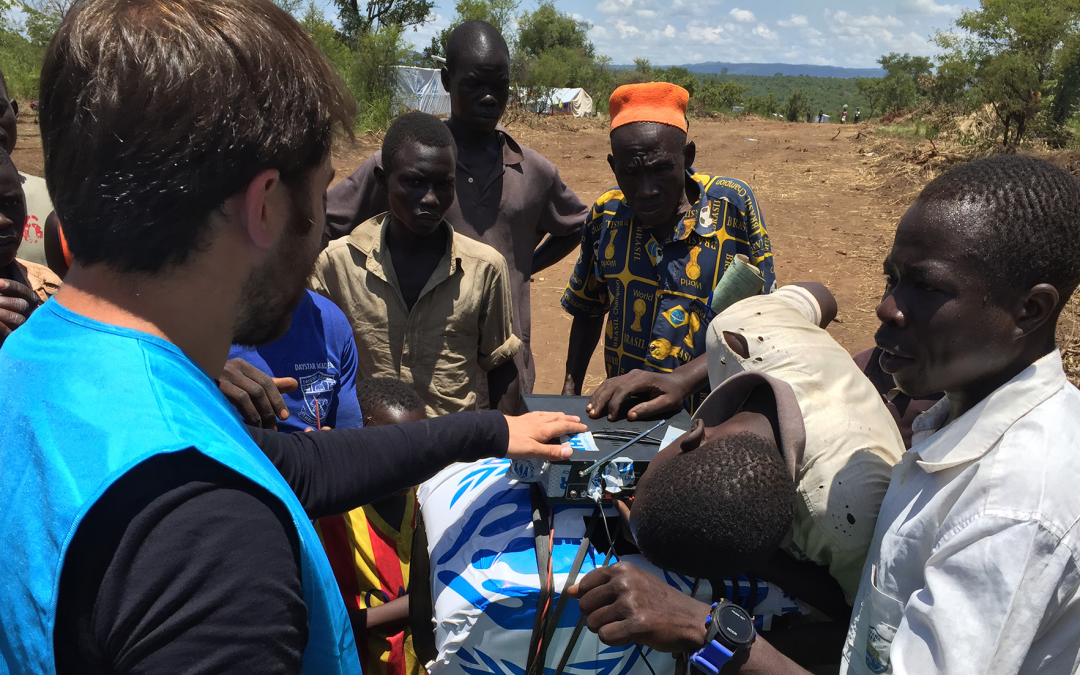In the humanitarian sector, knowing even a little bit about technology can take you a long way. Comparatively, with many other sectors public and private, we’ve been a little behind the times when it comes to adopting and adapting to new technologies and bringing in people with the right skill sets to effectively harness them. This is no surprise given that many of the contexts we’re working in have been less connected and occasionally dangerous, not to mention politically complex.
As such having a little bit of an insight has managed to allow these tech-humanitarians to take centre stage and build a following across social media. This has also resulted in a plethora of conferences and panel (read:‘Manel’) discussions with panelists playing buzzword bingo with the latest tech jargon.
And this misses the point of Innovation. It becomes an ego trip; a vehicle for oneself rather than a vehicle for the cause, the users or even the technology itself.
This is why UNHCR’s Innovation Service has come out strongly with a message that innovation and technology are not the same.
We like to focus on communities. Those who are receiving humanitarian assistance and are looking to improve their lives and live with dignity. Any product or service that we are involved with has to serve the needs of the user; we don’t want to use technologies for the sake of using them, nor seek out challenges to apply the technology to, putting the cart before the horse.
Are we a bunch of technophobes then? Absolutely not. And this brings me to the point of my post – to unpack a little about how we view technology, how we want to approach it and how it can support innovation in the most effective ways. As having a role – and current job title – that directly relates to technology, the stance we have taken initially made me uncomfortable. But through the work, we recognised our role was to pull the pendulum in the other direction, and that the nuances of our approach are worth debating and discussing with a broader audience.
Firstly, I’ll start with the fact that we aren’t a technology company, a web development company or product manufacturer. However much we, or some of our peers, think we might be – or are able to be – I believe there are better and more qualified people for whom this is their core business. And on top of that, there is legal status and mandate. Is the United Nations going to start developing apps for everything? Right now, we don’t really have a great track record in delivering digital services compared to the private sector, or even the public sector, save for a few pioneering international organisations. I see our role in understanding technology, applying humanitarian principles to it (akin to what is noted in The Signal Code) – and doing our utmost to ensure that it works in favour of our constituents.
Finally, if you start developing products or services yourself, you can quickly fall into the trap of peddling them for all possible opportunities, going against the age-old truth that challenges come before solutions.
Secondly, I’d like to provide a breakdown of how I see the intersect between innovation and technology, and how humanitarians may address each of the areas. I’ve split it into four different categories that essentially could be one big quadrant graph of Innovative approaches and technology.
That isn’t to say any of these approaches are wrong. In fact, they’re all really valuable and necessary for us to adapt with the times. What we have had to figure out as UNHCR’s Innovation Service is where our efforts are best placed, and where others may be better positioned to apply.
1. Application of Technology. This is essentially what we’re doing each day, every day. Technology can be anything from a pencil through to a laptop and smartphone. And it’s not only the basics – I’d also include tools that have been around for awhile and have become more commonplace in humanitarian delivery. Mass SMS systems come to mind, such as our previous Ascend project, as do hotlines, and mobile data collection even has been around long enough for me to consider its use really something that should be a mainstay of what we’re doing. We find it bizarre that some of these are considered by some as ‘innovative’ when in fact the application is straightforward, and the technology mature. In sum, we see this as tech that is commonly applied in humanitarian use cases.
2. Application of Innovative Technology. This essentially could be considered part of modernisation efforts. For instance around trying to upgrade our internal systems, using massive touch screens, even things like using VR for our external communications work, but you know my thoughts about that. This is essentially technology that has just been introduced to market, fits a very particular niche, or is still in experimental phases of development. Nonetheless, people have made forays into applying the technology in a humanitarian setting based on its corporate potential for which it has inevitably been developed.
So that’s not the kind of stuff that UNHCR’s Innovation Service includes in its mandate of responsibilities. These sort of applications, particularly the benefits around modernisation can only be brought to bear if the main divisions and departments of large organisations take this on board. If we look at it in our Innovation cave, then it will never scale and have the impact that it needs. Plus, it’s not actually about us being more innovative.

3. Innovative Application of Technology. To be honest, we have a fond spot for this point. Maybe it’s because more of the simple and mature technologies are commonplace, affordable, and accessible in many of the contexts we’re working in. And often because it is the most impactful, and the most overlooked. For instance, the Boda Boda Talk Talk project in Uganda. This was an idea born out of an Internews project in South Sudan. The technology was simple yet the approach to using it, and how the communities experimented and evolved how they used it was innovative. They found new ways of approaching the technology and were driven around solutions of communication. In this case, we borrowed an application and by allowing it to constantly evolve it became innovative.
4. Innovative Application of Innovative Technology. Some people would probably call this the ‘money shot’ for an Innovation Service, but we don’t see this really any differently from any innovative application of other technology, or no technology at all. Nonetheless, it can be exciting to find ways of bringing new innovative technology to bear in ways that are unique to the communities they are meant to serve, or that provide us with the insights that we specifically need. As mentioned earlier, we don’t take a technology and look for a challenge, but boy do we try and stay up to date so that when we’re working with a field operation looking to make a remote training experience more immersive, we understand what the capabilities of VR are and the role it plays in our ‘tool belt’ of solutions. Another example might be Project Jetson, which is striving to use as much data as possible to predict population movements to help us better prepare. The only way to compute this is by using some of the most innovative technologies available today.
So while Innovation ≠ Technology, technology can be innovative, innovation can use technology to innovate, and it can also be applied in innovative ways, or not. There are some important modernisation efforts underway in all humanitarian organisations. These should not be dismissed as benign; they are vitally important, but not necessarily innovation.
Merely using the most innovative technology available will not always mean its application in humanitarian settings is innovative. It could be misplaced or at worst, frankly, damaging.
While of course we will continue to explore and test nascent technologies, we won’t shout loud about it without having identified suitable and tangible use cases that will positively affect the lives of the communities we’re serving. Similarly while it is a huge amount of work, we won’t personally be shouting about modernisation efforts that are simply making our internal systems more efficient, rather than using innovative approaches to tackle some of our more complex challenges.
We’re always looking for great stories, ideas, and opinions on innovations that are led by or create impact for refugees. If you have one to share with us send us an email at [email protected]
If you’d like to repost this article on your website, please see our reposting policy.

